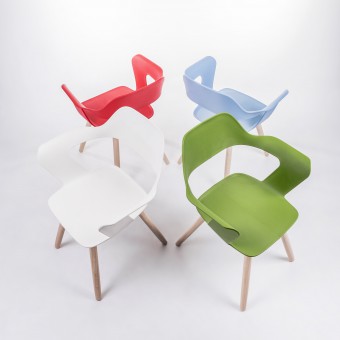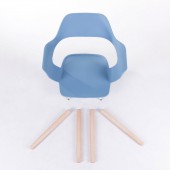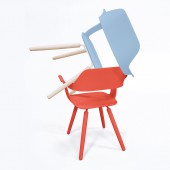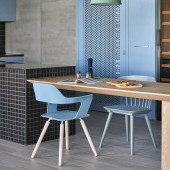
| THE AWARD |
| CATEGORIES |
| REGISTRATION |
| SUBMIT YOUR WORK |
| ENTRY INSTRUCTIONS |
| TERMS & CONDITIONS |
| PUBLICATIONS |
| DATES & FEES |
| METHODOLOGY |
| CONTACT |
| WINNERS |
| PRESS ROOM |
| GET INVOLVED |
| DESIGN PRIZE |
| DESIGN STORE |
| THE AWARD | JURY | CATEGORIES | REGISTRATION | PRESS | WINNERS | PUBLICATIONS | ENTRY INSTRUCTIONS |
Muse Knockdown Chair by HanYi Huang |
Home > Winners > Design #48510 >Interview |
 |
|
FS: What is the main principle, idea and inspiration behind your design?
HH: The main target was to design a functional, aesthetical pleasing chair that would be affordable to the end customer.
FS: What has been your main focus in designing this work? Especially what did you want to achieve?
HH: This project did not have a single focus as it was a pretty complex one and throughout its lifecycle, a chair like MUSE has many stakeholders that influence design decisions. First, for the producer, this, should be a chair that would be appealing to a vast range of markets (contract or retail, indoor or outdoor, residential or public space) so that its investment would return back and would yield as much profit as possible. For the wholesalers it should be a chair with competitive price, that would have little transportation cost (more chairs in a single container, that is why is knocked down) and take little space in warehouses (again, knocked down to save space). Finally for the end user, it should be a chair that could be bought again in a competitive price, it would be safe, comfortable and of course would be aesthetically pleasant and match the overall environment he char will be placed.
FS: What are your future plans for this award winning design?
HH: The chair is already in production as it passed all the quality and safety tests and the aim is to promote it internationally to existing and new customers.
FS: How long did it take you to design this particular concept?
HH: The actual design and refinement cycle lasted approximately 4 months but the overall development, prototyping and testing over than 2 years
FS: Why did you design this particular concept? Was this design commissioned or did you decide to pursuit an inspiration?
HH: MUSE was designed after it was received a design brief from the Management and Marketing team of Shiang Ye Ind. Co. Ltd
FS: Is your design being produced or used by another company, or do you plan to sell or lease the production rights or do you intent to produce your work yourself?
HH: MUSE is produced and marketed solely by Shiang Ye Ind. Co. Ltd
FS: What made you design this particular type of work?
HH: As mentioned before, MUSE chair was designed after it was commissioned by the Management and Marketing team of Shiang Ye Ind. Co. Ltd
FS: Where there any other designs and/or designers that helped the influence the design of your work?
HH: The chair was designed with the help and influence of the in-house designers and engineering team of Shiang Ye Ind. Co. Ltd. A chair is a challenging product in terms of ergonomics, safety requirement and production and for this reason, the collaboration with the R&D team of Shiang Ye Ind. Co. Ltd. was necessary but also very valuable.
FS: Who is the target customer for his design?
HH: The market for MUSE is very diverse. The customer may be a Public Authority (ex. Library, University) or a Corporation with hundreds of employees that will need to equip their premises, or SME Companies (ex. Café/Restaurants, Offices) but even individuals who would like to equip their house or garden.
FS: What sets this design apart from other similar or resembling concepts?
HH: MUSE is a fully equipped chair with armrests and its characteristics bold legs that not only give a unique visual identity and a solid appearance to the chair but also well hide the fact that the chair can be dissembled for ease during transportation but also to reduce its retail price and be more affordable. Furthermore for the plastics legs, it is used a special technique to coat them with a variety of wood-look-like films that create a harmonious look alongside the plastic, curvy and welcoming seating part. This technique was the first time to be applied in 360 degrees and in such a big and plastic part. Finally, MUSE with its modular character can have numerous color combinations between its seating and leg part that make it a very flexible chair to fit almost any indoor or outdoor space, something that customers value a lot.
FS: How did you come up with the name for this design? What does it mean?
HH: MUSE’s name derives from the 9 Ancient Greek goddesses of inspiration related to arts (Muses, plural). We hoped that the chair’s versatile character could inspire interior designers and individual users to configure their MUSE chair in a way that will better fit their environment.
FS: Which design tools did you use when you were working on this project?
HH: For the different stages of its Development, we used numerous analogue and digital design tools. We started with rough hand drawings that where later translated to rough CAD models to evaluate the overall design quality of the product. Then we moved in to more precise CAD modelling with specialized software to create the first rapid prototype parts to evaluate MUSE’s Ergonomics and Design. Then, a series of adjustments took place in the CAD model before the engineers start producing the CAD designs for the molds.
FS: What is the most unique aspect of your design?
HH: The most striking element of MUSE is the contrast of its bold legs that are spreading towards the bottom to give a robust, solid look in sharp contrast to the visually lightweight, curvy formed seating top-part that has a more calm and welcoming appearance.
FS: Who did you collaborate with for this design? Did you work with people with technical / specialized skills?
HH: For such a complex project is was necessary to closely collaborate with the in-house Engineering Team of Shiang Ye Ind. Co. Ltd. . Their Engineers with years of experience of developing chairs provided valuable information from very early on during MUSE’s development. Without them the overall process would be much more difficult and would last much longer.
FS: What is the role of technology in this particular design?
HH: Technology played a significant role during the Design & Development. Specialized CAD software helped to translate the hand sketches to 3D models but also 3D printed models to quickly and cheaply evaluate the chair’s development. Then, through specialized CAD software the Engineers simulated the plastic flow inside the molds as well as run preliminary stress tests for the chair. These digital simulations gave valuable feedback to the Design team to optimize the design to its final state. Should we did not have access to this specialized technological equipment, MUSE’s development time would be much longer and much more expensive for the Shiang Ye Ind. Co. Ltd
FS: Is your design influenced by data or analytical research in any way? What kind of research did you conduct for making this design?
HH: Shiang Ye Ind. Co. Ltd ‘s Marketing Team had collected relevant data from its Customers (mainly Agents and Wholesalers) who had described market gaps and needs that the new product should carry. As such the chair was equipped with arms, it was designed as a knocked-down chair but when assembled looked like a robust chair and it was offered in an extensive color and trim combinations.
FS: What are some of the challenges you faced during the design/realization of your concept?
HH: The biggest challenge was to maintain the original form as presented in the initial sketches while the chair will be able to pass all the necessary quality and safety tests as prescribed by Authorities in Europe and USA. We believe that the team of Designers and Engineers manage to blend Design and Manufacturability in a successful way and the A-Design Award verifies our common effort.
FS: How did you decide to submit your design to an international design competition?
HH: In the end of this Project, we were very excited and proud for the outcome of our work and we wanted to put MUSE next to hundreds of others competing for the same Award. We were confident and it was very rewarding to be informed that was finally recognized and awarded. Furthermore, a Design Award is a strong selling point in the highly competitive and demanding furniture market.
FS: What did you learn or how did you improve yourself during the designing of this work?
HH: During this project, collectively, within Shiang Ye Ind. Co. Ltd we had the opportunity to use new technologies in software (like plastic flow analysis) and production techniques (decorative film-covered plastic legs) to realize MUSE chair. These are new tools in our toolkit that we are looking forward to use in our new projects.
FS: Any other things you would like to cover that have not been covered in these questions?
HH: No
FS: Thank you for providing us with this opportunity to interview you.
A' Design Award and Competitions grants rights to press members and bloggers to use parts of this interview. This interview is provided as it is; DesignPRWire and A' Design Award and Competitions cannot be held responsible for the answers given by participating designers.
| SOCIAL |
| + Add to Likes / Favorites | Send to My Email | Comment | View Press-Release |





